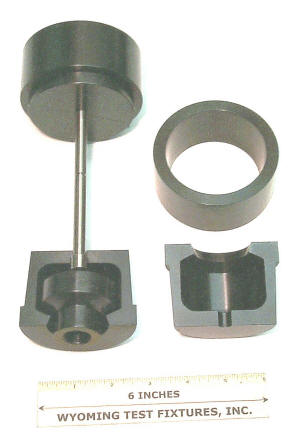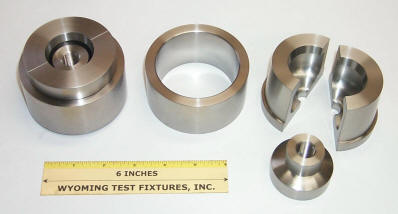Split Collar Tensile Grips (ASTM F519)

Fig. 1: Split Collar Grips used to test ASTM F519, type 1a.2 specimens. The standard specimen shown has knob ends and a circumferentially-grooved (reduced area) section at its center.
Split collar grips are typically used to tensile test round bar specimens having enlarged ends and reduced central cross sections. They provide a unique type of gripping. Spherical seats can be built in also, to aid in minimizing induced bending in the specimen. Candidate specimen materials include, in particular, brittle metals and ceramics.
There are a wide variety of specimen sizes and configurations in use. As one example, grips to test ASTM F519 type specimens (Reference 1) are shown in Fig. 1. The tapered sleeves slip over the tapered split collars to hold them in place after the specimen is installed. Note the spherical seat inserts where the grips attach to the testing machine (the lower insert can be seen in Fig. 1).
Another pair of split collar grips, similar to the above pair, with specimen contact surfaces contoured to match the 1/8” radiused shoulders of the specimen ends, are shown in Fig. 2. The spherical seat in the threaded testing machine attachment fitting can be better seen in this photograph also.

Fig. 2: Split Collar Grips used to test brittle ceramic specimens 1/8” diameter specimen bearing radii, and spherical seat end attachments.
Source of Additional Information:
1) ASTM Standard F 519-13 (2013), "Standard Test Method for Mechanical Hydrogen Embrittlement Evaluation of Plating Processes and Service Environments,” American Society for Testing and Materials, West Conshohocken, Pennsylvania (first published in 1997).

